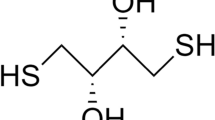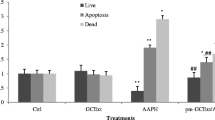Abstract
To investigate the effect of polypeptide fromChlamys farreri (PCF) on NHDFin vitro, we modeled oxidative damage on normal human dermal fibroblasts (NHDF) exposed to ultraviolet B (UVB). In this study, 3-[4,5-Dimethylthiazol-2-yl]-2,5-diphenyltetrazolium bromide (MTT) and lactate dehydrogenase (LDH) were tested to measure cell viability. Enzymes including superoxide dismutase (SOD), glutathione peroxidase (GSH-PX), catalase (CAT) and xanthine oxidase (XOD) were determined biochemically. Total antioxidative capacity (T-AOC) and anti-superoxide anion capacity (A-SAC) were also determined. Ultrastructure of fibroblasts was observed under transmission electron microscope. The results showed that: UVB (1.176×10−4 J/cm2) suppressed the growth of fibroblasts and the introduction of PCF (0.25%–1%) before UVB reduced the suppression in a concentration-dependent manner. PCF could enhance the activities of SOD, GSH-PX and T-AOC as well as A-SAC. Also PCF could inhibit XOD activity, while it did not affect CAT activity. Ultrastructure of fibroblasts were damaged after UVB irradiation, concentration-dependent PCF reduced the destructive effect of UVB on cells. These results indicated that PCF can protect human dermal fibroblasts from being harmed by UVB irradiation via its antioxidant proerty.
Similar content being viewed by others
References
Budiyanto A, N. U. Ahmed, A. Wu, T. Bito, O. Nikaido, T. Osawa and M. Ueda, 2000. Protective effect of topically applied olive oil against photocarcinogenesis following UVB exposure of mice.Carcinogenesis 11: 2085–2090.
Chen, P. Q., J. Yuan, Q. Y. Du, L. Chen, G. Q. Li, Z. Y. Huang, D. D. Yang and L. N. Wu, 2000. Effects of ddihydroartemisinim on fine structure of erythrocytic stages ofPlasmodium berghei ANKA strain.Acta Pharmacol. Sin. 3: 234–238.
Cory, A. H., T. C. Owen, J. A. Barltrop and J. G. Cory, 1991. Use of an aqueous soluble tetrazoliium/formazan assay for cell growth assays in culture.Cancer Commun. 3: 207–212.
Djavaheri-Mergeny, M., J. C. Maziere, R. Santus, L. Mora, C. Maziere, M. Auclair and L. Dubertret, 1993. Exposure to long wavelength ultraviolet radiation decreases processing of low density lipoproteins by cultured human fibroblasts.Photochem. Photobiol. 2: 302–305.
Eaterbauer, H., J. Gebicki, H. Puhl and G. Jurgens, 1992. The role of lipid peroxidation and antioxidants in oxidative modification of LDL.Free Radic. Biol. Med. 4: 341–390.
Fridovich, I., 1995. Superoxide radical and superoxide dismutase.Annu Rev Biochem 64: 97–112.
Hasegawa, T., F. Kaneko and Y. Niwa, 1992. Changes in lipid peroxide levels and activity of reactive oxygen scavenging enzymes in skin, serum and liver following UVB irradiation in mice.Life Sci. 24: 1893–1902.
Iizawa, O., T. Kato, H. Tagami, H. Akamatsu and Y. Niwa, 1994. Long-term follow-up study of changes in lipid peroxide levels and the activity of superoxide dismutase, catalase and glutathione peroxidase in mouse skin after acute and chronic UV irradiation.Arch. Dermatol. Res. 286: 47–52.
Jones, G. E. and C. J. Wise, 1997. Establishment, maintenance, and cloning of human dermal fibroblasts. In: Pollard JW, Walker JM, eds. Basic cell culture protocols.Totowa: Humana Press 75: p. 13–21.
Morliere, P., A. Moysan, R. Santus, G. Huppe, J. C. Maziere and L. Dubertret, 1991. UVA-induced lipid peroxidation in cultured human fibroblasts.Biochim. Biophys. Acta 3: 261–268.
Podda, M., M. G. Traber, C. Weber, L. J. Yan and L. Packer, 1998. UV-irradiation depletes antioxidants and causes oxidative damage in a model of human skin.Free Radic Biol. Med. 1: 55–65.
Santus, R., L. Perdrix, J. Haigle, P. Morliere, J. C. Maziere, C. Maziere and C. Labrid, 1992. Daflon as a cellular antioxidant and a membrane-stabilizing agent in human fibroblasts irradiated by ultraviolet A.Photoderm. Photoimmunol. Photomed 8: 200–205.
Shen, J. G., X. S. Quo, B. Jiang, M. Li, W. Xin and B. L. Zhao, 2000. Chinonin, a novel drug against cardiomyocyte apoptosis induced by hypoxia and reoxygenation.Biochim. Biophys. Acta. 1500: 217–226.
Wang, C. B., M. Q. He, S. Z. Qin, Y. Z. Wang, W. Z. Zhong, Z. Y. Xu and Z. X. Wen, 1998. Antioxidative effect of polypeptide fromChlamys farreri in vitro.Chinese Journal of Marine Drugs 3: 15–17.
Wang, C. B., R. Y. Yao, Z. T. Liu, W. Z. Zhong, X. P. Liu and Y. J. Wang, 2003. Protective effects of polypeptide fromChlamys farreri on hairless mice damaged by ultraviolet A.Acta. Pharmacol. Sin. 9: 813–818.
Yasui, H. and H. Sakurai, 2000. Chemilunescent detection and imaging of reactive oxygen species in live mouse skin exposed to UVA.Biochem. Biophys. Res. Commun. 1: 131–136.
Author information
Authors and Affiliations
Corresponding author
Additional information
This work was supported by the National Natural Science Foundation of China (No. 39970638) and the Science and Technology Bureau of Qingdao (No. 2001-28-50).
Rights and permissions
About this article
Cite this article
Yujiang, Z., Songmei, Z., Pengli, C. et al. The polypeptide inChlamys farreri can protect human dermal fibroblasts from ultraviolet B damage. Chin. J. Ocean. Limnol. 23, 357–362 (2005). https://doi.org/10.1007/BF02847161
Received:
Accepted:
Issue Date:
DOI: https://doi.org/10.1007/BF02847161




